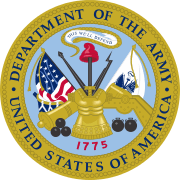Holston Army Ammunition Plant
Coordinates: 36°31′59″N 82°37′54″W / 36.533192°N 82.63165°W
| Joint Munitions Command (JMC) | |
|---|---|
| Active | 2003 - present |
| Country | United States |
| Type | Major Subordinate Command of the United States Army Materiel Command (AMC) |
| Role | Operate a nationwide network of facilities where conventional ammunition is produced and stored. |
| Size | Employs 20 military, over 5800 civilians and 8300 contractor personnel |
| Colors | red, yellow, white, black, blue |
| Website | www.jmc.army.mil |
| Commanders | |
| Current commander | Brigadier General Larry Wyche |
The mission of Holston Army Ammunition Plant (HSAAP) is to manufacture Research Department Explosive (RDX) and High Melting Explosive (HMX) for ammunition production and development. Research and development plays a vital role in the production of new and better explosives and products. It is government-owned and contractor-operated (GOCO). Information Provided by the Joint Munitions Command
The Holston Army Ammunition Plant, also known as the Holston Ordnance Works, was constructed by Tennessee Eastman in Kingsport, Tennessee to manufacture explosives during World War II.
BAE Systems' division Ordnance Systems, Inc. currently operates the plant under a 25-year facilities use contract. On May 12, 2011, the Army announced that BAE Systems had won the contract to operate Radford Army Ammunition Plant in nearby Radford, VA as well.
Capabilities
Capabilities of the plant include: production and development of insensitive munitions explosives; synthesis and manufacture of high explosives; recrystallization and purification from organic solvents; melt-cast, cast-cured, pressed and extruded explosives formulation; explosives performance testing; full-spectrum explosives research and development capability; and custom and fine chemical manufacture for the defense industry. Information Provided by the Joint Munitions Command
Current operations
The current plant is on two sites: Plant A is in Kingsport, and Plant B is about 4 miles (6.4 km) away in a less developed part of Hawkins County. The two plants are connected by rail. Plant A has 120 acres (0.49 km2). Plant B has 5,900 acres (24 km2). The site as a whole includes 465 buildings.[1]
History
Holston Ordnance Works [HOW] was established in July 1942 and stopped production in 1945. It was reactivated in 1949 during the Cold War and continues today. The installation was renamed Holston Army Ammunition Plant [HSAAP or HAAP] in the early 1960s. Holston Defense Corporation operated the facility from 1949 through 1999 under a series of cost reimbursement contracts with the U. S. Army.[1]
The plant was constructed 1942-1944 for use by the government contractor, Tennessee Eastman Corporation, a subsidiary of Eastman Kodak. During World War II, it manufactured Composition B, a very powerful explosive mixture of RDX and TNT. The facility was placed in standby status after World War II, producing only fertilizer, until it was reactivated in 1949 under the Holston Defense Corporation, a new subsidiary of Eastman Kodak.[1]
During the Korean War, the plant continued to manufacture Composition B as well as rework its stockpiled Composition B. New production lines were built during 1951-1954 in order to produce for the war. However, after the Korean War it was reduced to a one-line operation. It did not resume large-scale production until the mid-1960s when it was again modernized to produce large amounts of Composition B for the Vietnam War.[1]
After 1973, production was again reduced to a much smaller amount, but the plant also began producing “special-order” explosives and propellants for the Armed Services, including the Navy’s Trident missile program. It also handles and stores material for the national defense stockpile.[1]
As of 1988, the plant produced all of the RDX/HMX consumed in the USA, and 90 percent of that used by all of the nations friendly to the USA.[1]
Facilities
HSAAP is housed on 6,024 acres (24.38 km2) with 325 buildings, 130 igloos and storage capacity of 275,000 square feet (25,500 m2).Information Provided by the Joint Munitions Command
References
External links
- Joint Munitions Command website
- Information compiled from
![]() This article incorporates public domain material from the United States Government document "http://www.jmc.army.mil".
This article incorporates public domain material from the United States Government document "http://www.jmc.army.mil".
